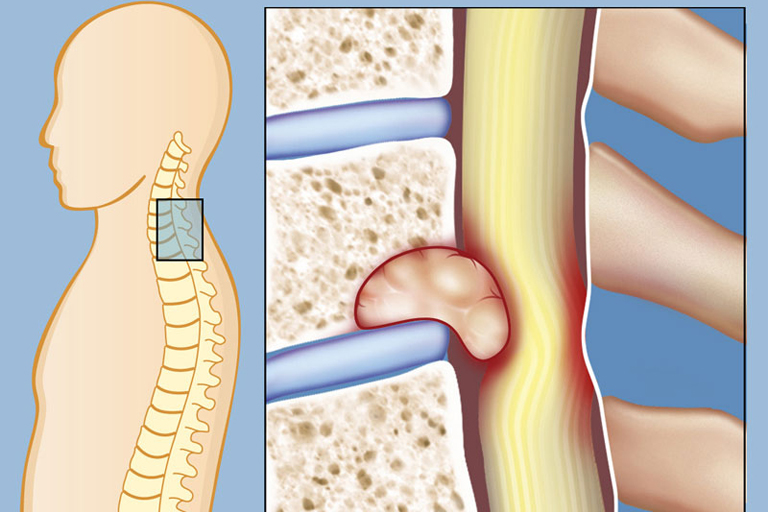Spinal Tumor

A spinal tumor is an abnormal mass of tissue within or surrounding the spinal cord and/or spinal column. These cells grow and multiply uncontrollably, seemingly unchecked by the mechanisms that control normal cells. Spinal tumors can be benign (non-cancerous) or malignant (cancerous). Primary tumors originate in the spine or spinal cord, and metastatic or secondary tumors result from cancer spreading from another site to the spine.
Spinal tumors are referred to in two ways.
By the region of the spine in which they occur. These basic areas are cervical, thoracic, lumbar and sacrum.
By their location within the spine.
- Intradural-extramedullary – The tumor is located inside the thin covering of the spinal cord (the dura), but outside the actual spinal cord. Frequency of occurrence in this location is 40%. The most common of these types of tumors develop in the spinal cord's arachnoid membrane (meningiomas), in the nerve roots that extend out from the spinal cord (schwannomas and neurofibromas), or at the spinal cord base (filum terminale ependymomas). Although meningiomas are often benign, they can be difficult to remove and may recur. Nerve root tumors are also generally benign, although neurofibromas may become malignant over time. Ependymomas at the end of the spinal cord can be large, and the delicate nature of fine neural structures in that area may make removal difficult.
- Intramedullary – These tumors grow inside the spinal cord. They typically derive from glial or ependymal cells (a type of glial cell) that are found throughout the interstitium of the spinal cord. Frequency of occurrence in this location is approximately 5%. Astrocytomas and ependymomas are the two most common types. Astrocytomas are more common in the thoracic region followed by the cervical. Ependymomas are most common in the filum (bottom region of the spinal cord), followed by the cervical region. They are often benign (compared to intracranial), but can be difficult to remove. Intramedullary lipomas are rare congenital tumors most commonly located in the cervicothoracic spinal cord.
- Extradural – The tumor is located outside the dura, which is the thin covering surrounding the spinal cord. Frequency of occurrence in this location vs the ones above is approximately 55%. These lesions are typically attributed to metastatic cancer or less commonly schwannomas derived from the cells covering the nerve roots. Occasionally, an extradural tumor extends through the intervertebral foramina, lying partially within and partially outside of the spinal canal.
The bony spinal column is the most common site for bone metastasis. Estimates indicate that at least 30% and as high as 70% of patients with cancer will experience spread of cancer to their spine. The most common primary spine tumor (originated in the bony spine) is vertebral hemangiomas. These are benign lesions and rarely cause symptoms such as pain.
Common primary cancers that spread to the spine are lung, breast and prostate. Lung cancer is the most common cancer to metastasize to the bone in men, and breast cancer is the most common in women. Other cancers that spread to the spine include multiple myeloma, lymphoma, melanoma and sarcoma, as well as cancers of the gastrointestinal tract, kidney and thyroid. Prompt diagnosis and identification of the primary malignancy is crucial to overall treatment. Numerous factors can affect outcome, including the nature of the primary cancer, the number of lesions, the presence of distant non-skeletal metastases and the presence and/or severity of spinal-cord compression.
Pediatric Spinal Tumors
- Osteoid Osteoma
- Osteoblastoma
- Osteochondroma
- Osteosarcoma
- Ewing Sarcoma
- Eosinophilic Granuloma
- Aneurysmal Bone Cyst
- Ahordoma
- Mesenchymal Chondrosarcoma
- Giant-Cell Tumor Of Bone
- Fibrous Dysplasia
- Fibroma
- Angiosarcoma
- Hemangioma
Symptoms
Non-mechanical back pain, especially in the middle or lower back, is the most frequent symptom of both benign and malignant spinal tumors. This back pain is not specifically attributed to injury, stress or physical activity. However, the pain may increase with activity and can be worse at night when lying down. Pain may spread beyond the back to the hips, legs, feet or arms and may worsen over time — even when treated by conservative, nonsurgical methods that can often help alleviate back pain attributed to mechanical causes. Depending on the location and type of tumor, other signs and symptoms can develop, especially as a tumor grows and compresses on the spinal cord, the nerve roots, blood vessels or bones of the spine.
Additional symptoms can include the following:
- Loss of sensation or muscle weakness in the legs, arms or chest
- Stiff neck or back
- Pain and/or neurologic symptoms (such as tingling) increase with Valsalva maneuver
- Difficulty walking, which may cause falls
- Decreased sensitivity to pain, heat and cold
- Loss of bowel or bladder function
- Paralysis that may occur in varying degrees and in different parts of the body, depending on which nerves are compressed
- Scoliosis or other spinal deformity resulting from a large and/or destructive tumor